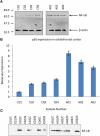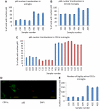Aberrant NF-kappaB expression in autism spectrum condition: a mechanism for neuroinflammation
- PMID: 21629840
- PMCID: PMC3098713
- DOI: 10.3389/fpsyt.2011.00027
Aberrant NF-kappaB expression in autism spectrum condition: a mechanism for neuroinflammation
Abstract
Autism spectrum condition (ASC) is recognized as having an inflammatory component. Post-mortem brain samples from patients with ASC display neuroglial activation and inflammatory markers in cerebrospinal fluid, although little is known about the underlying molecular mechanisms. Nuclear factor kappa-light-chain-enhancer of activated B cells (NF-κB) is a protein found in almost all cell types and mediates regulation of immune response by inducing the expression of inflammatory cytokines and chemokines, establishing a feedback mechanism that can produce chronic or excessive inflammation. This article describes immunodetection and immunofluorescence measurements of NF-κB in human post-mortem samples of orbitofrontal cortex tissue donated to two independent centers: London Brain Bank, Kings College London, UK (ASC: n = 3, controls: n = 4) and Autism Tissue Program, Harvard Brain Bank, USA (ASC: n = 6, controls: n = 5). The hypothesis was that concentrations of NF-κB would be elevated, especially in activated microglia in ASC, and pH would be concomitantly reduced (i.e., acidification). Neurons, astrocytes, and microglia all demonstrated increased extranuclear and nuclear translocated NF-κB p65 expression in brain tissue from ASC donors relative to samples from matched controls. These between-groups differences were increased in astrocytes and microglia relative to neurons, but particularly pronounced for highly mature microglia. Measurement of pH in homogenized samples demonstrated a 0.98-unit difference in means and a strong (F = 98.3; p = 0.00018) linear relationship to the expression of nuclear translocated NF-κB in mature microglia. Acridine orange staining localized pH reductions to lysosomal compartments. In summary, NF-κB is aberrantly expressed in orbitofrontal cortex in patients with ASC, as part of a putative molecular cascade leading to inflammation, especially of resident immune cells in brain regions associated with the behavioral and clinical symptoms of ASC.
Keywords: NF-κB; autism spectrum condition; brain; inflammation; orbitofrontal cortex; pH.
Figures




References
-
- Akiyama H., Nishimura T., Kondo H., Ikeda K., Hayashi Y., Mcgeer P. L. (1994). Expression of the receptor for macrophage colony stimulating factor by brain microglia and its upregulation in brains of patients with Alzheimer's disease and amyotrophic lateral sclerosis. Brain Res. 639, 171–17410.1016/0006-8993(94)91779-5 - DOI - PubMed
-
- Anderson M. P., Hooker B. S., Herbert M. R. (2008). Bridging from cells to cognition in autism pathophysiology: biological pathways to defective brain function and plasticity. Am. J. Biochem. Biotechnol. 4, 167–176
-
- Barnes P. J., Karin M. (1997). Nuclear factor-kappaB: a pivotal transcription factor in chronic inflammatory diseases. N. Engl. J. Med. 336, 1066–1071 - PubMed
-
- Baron-Cohen S. (2002). The extreme male brain theory of autism. Trends Cogn. Sci. 6, 248–254 - PubMed
Grants and funding
LinkOut - more resources
Full Text Sources
Miscellaneous

